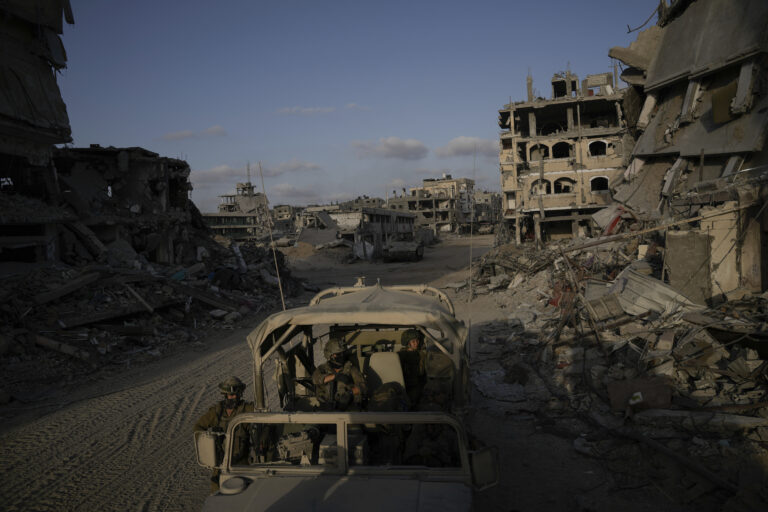 In a military buildup certain to inflame tensions with China, the United States said Thursday it has been conducting joint South China Sea patrols — and eventually will conduct air patrols — with the Philippines, while dispatching U.S. troops and combat aircraft there on more frequent rotations.
In a military buildup certain to inflame tensions with China, the United States said Thursday it has been conducting joint South China Sea patrols — and eventually will conduct air patrols — with the Philippines, while dispatching U.S. troops and combat aircraft there on more frequent rotations.
The announcement by Defense Secretary Ash Carter in a news conference with Philippine Defense Secretary Voltaire Gazmin was the first time the U.S. revealed that its ships had conducted patrols with the Philippines in the South China Sea, a somewhat rare move not done with many other partners in the region.
While Carter insisted the U.S. did not intend to be provocative and was “trying to tamp down tensions here,” Gazmin said he expects that U.S. forces, “with their presence here, will deter uncalled-for actions by the Chinese.”
While the military boost doesn’t include permanent basing for U.S. troops, Beijing views any increased U.S. military presence and activities in the region as a threat.
“Military exchanges by relevant countries should not target third parties, much less support a few countries in challenging China’s sovereignty and security, inciting regional contradictions and sabotaging regional peace and stability,” the Chinese Foreign Ministry said in a statement in response to Carter’s announcement.
“At present, the situation in the South China Sea is stable overall due to the common efforts of China and relevant regional countries. China resolutely opposes any country harming China’s sovereignty and security and sabotaging peace and stability in the South China Sea under any conditions,” the statement read.
Carter said the United States will be keeping nearly 300 troops, including Air Force commandos armed with combat aircraft and helicopters, in the Philippines through the end of the month. The U.S. will also increase troop rotations to strengthen training and support increased military operations in the region.
Speaking in the guest house of the presidential complex, Carter said the joint patrols will improve the Philippine’s navy and “contribute to the safety and security of the region’s waters.”
The increase in military support comes just days after the Philippines’ ambassador to the United States asked the U.S. to help persuade China not to build in the nearby Scarborough Shoal, which is viewed as important to Filipino fishermen. Ambassador Jose Cuisia Jr. said the Philippines cannot stop China from building there. China has built man-made islands in other contested spots in the South China Sea.
Charlito Maniago, the leader of a northwestern Philippine village where many fishermen lost access to the disputed Scarborough Shoal after China seized it in 2012, said the joint patrols will spark hope that they can sail freely again to the rich fishing ground.
“This will boost the confidence of our fishermen because they think the U.S. has the capability to defend them,” Maniago told The Associated Press by telephone from the coastal village of Cato in Pangasinan province. “The presence of America will make China think twice.”
Maniago, however, expressed concern that if China takes a more hard-line position because of Washington’s increasing involvement in the disputed waters “a dangerous situation may happen and our fishermen may all the more lose the chance to fish in those waters.”
The Pentagon said the U.S. forces that will remain in the Philippines are already there participating in the Balikatan, or shoulder-to-shoulder combat exercises, that will end Friday. About 200 airmen, including special operations forces, will remain at Clark Air Base, along with three of their Pave Hawk attack helicopters, an MC-130H Combat Talon II special mission aircraft and five A-10 combat aircraft.
This initial contingent will provide training to increase the two militaries’ ability to work together, laying the groundwork for forces to do joint air patrols as well as the ship movements.
Up to 75 Marines will also stay at Camp Aguinaldo to support increased U.S. and Philippine combined military operations in the region.
The troops and aircraft are expected to leave at the end of the month, but other U.S. forces and aircraft would do similar rotations into the Philippines routinely in the future. Carter would not say how frequently those rotations would happen, but called it a “regular periodic presence.”
The increased troop presence is part of a broader U.S. campaign to expand its assistance to the Philippines, as America shores up its allies in the Asia Pacific who are roiled by China’s building of manmade islands in the South China Sea.
Last week the Pentagon announced that the U.S. will give the Philippines about $40 million in military assistance to beef up intelligence sharing, surveillance and naval patrols. Carter said the aid will include an enhanced information network for classified communications, sensors for patrol vessels and an unmanned aerostat reconnaissance airship to help the island nation keep a watch over its territory.
The U.S. will also get access to five Philippine military bases to house American forces that will rotate in and out of the country for training and other missions.
Scarborough Shoal is at the center of a case that Manila filed with the Permanent Court of Arbitration, an international panel, in January 2013 after Chinese coast guard ships took effective control of the disputed land following a tense standoff with Filipino ships.
The shoal sits about 145 miles (230 kilometers) west of the Philippines, and 620 miles (1,000 kilometers) from the Chinese coast.
The court has agreed to take the case and is expected to rule in the coming months. Beijing has objected, saying the panel has no jurisdiction in the matter.
(AP)










